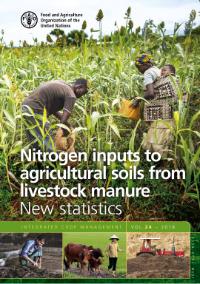Nitrogen inputs to agricultural soils from livestock manure. New Statistics
Resource information
Date of publication
октября 2018
Resource Language
License of the resource
The global agricultural sector today faces the double challenge of feeding a growing population while preserving the underlying natural resources of land, water and air. In the meantime, already a third of the world’s soils are degraded. Soil and nutrient management techniques aimed at restoring soil health will therefore be essential to meeting these challenges.
Livestock manure is a source of nitrogen and other plant nutrients when applied to soils. It is also high in organic matter and can help address soil deficiencies and improve soil quality. However, inappropriate manure management can have detrimental effects on the environment due to pollution from losses of excess nutrients to waterways and the atmosphere. This report sheds light on the amount of nitrogen applied to agricultural soils from livestock manure at different scales, and on the relevance of producing, refining and monitoring statistics on livestock manure for environmental and agronomic policy and planning. The report presents the relevant statistics available at FAO to this end, and demonstrates how they can be used for a nutrient input analysis at a national, regional and global level. The data include FAOSTAT chemical and mineral fertilizers statistics integrated with estimates of livestock manure from the FAOSTAT and the Global Livestock Environmental Assessment Model.This report is intended for use by various audiences, including agricultural statistics services or agencies in relevant line ministries, academia, industry and the general public in member countries, and provides country-level reference statistics using internationally-recognized and transparent methodologies.

